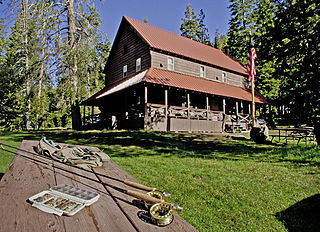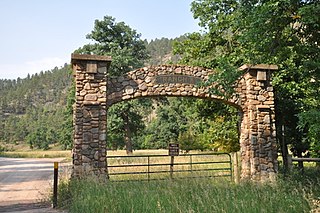
The Mogollon Rim is a topographical and geological feature cutting across the northern half of the U.S. state of Arizona. It extends approximately 200 miles (320 km), starting in northern Yavapai County and running eastward, ending near the border with New Mexico. It forms the southern edge of the Colorado Plateau in Arizona.

Hey Dude is an American Western comedy series that aired on Nickelodeon from July 14, 1989, to August 30, 1991, consisting of 65 half-hour episodes produced over five seasons.

Parshall is an unincorporated town, a post office, and a census-designated place (CDP) located in and governed by Grand County, Colorado, United States. The Parshall post office has the ZIP Code 80468. At the United States Census 2020, the population of the Parshall CDP was 42.

Pfeiffer Big Sur State Park is a state park in Monterey County, California, near the area of Big Sur on the state's Central Coast. It covers approximately 1,006 acres (4.07 km2) of land. The park is centered on the Big Sur River. It has been nicknamed a "mini Yosemite." A Redwood tree in the park nicknamed the Colonial Tree is estimated to be between 1,100 and 1,200 years old.
Midway House, also known as Broken M Bar Ranch and Meyer Ranch, is an 1889 Queen Anne ranch house located near Aspen Park, Colorado. It is listed on the National Register of Historic Places.

Lake George is an unincorporated community and a U.S. Post Office in Park County, Colorado, United States. The Lake George Post Office has the ZIP Code 80827. It lies along U.S. Highway 24 northwest of Colorado Springs, and several miles north of Florissant Fossil Beds National Monument.

Drakesbad Guest Ranch, also known simply as Drakesbad, is a resort near Chester, California. It is located on Hot Springs Creek at the head of Warner Valley, inside Lassen Volcanic National Park.

The 4 Lazy F Ranch, also known as the Sun Star Ranch, is a dude ranch and summer residence in Jackson Hole, Wyoming, built by the William Frew family of Pittsburgh in 1927. The existing property was built as a family retreat, not as a cattle ranch, in a rustic style of construction using logs and board-and-batten techniques. The historic district includes seven cabins, a lodge, barn corral and smaller buildings on the west bank of the Snake River north of Moose, Wyoming. The property was added to the National Register of Historic Places in 1990.

The Bar B C Dude Ranch was established near Moose, Wyoming in 1912 as a dude ranch by Struthers Burt and Dr. Horace Carncross, using their initials as the brand. Rather than converting a working ranch, Burt and Carncross built a tourist-oriented dude ranch from the ground up, using a style called "Dude Ranch Vernacular", which featured log construction and rustic detailing. As one of the first dude ranches in Jackson Hole, the Bar B C was a strong influence on other dude ranches in the area, and employed a number of people who went on to establish their own operations. It was acquired by the National Park Service and incorporated into Grand Teton National Park upon the expiration of a life estate. The ranch was listed on the National Register of Historic Places in 1990.

The Manges Cabin in Grand Teton National Park, also known as the Old Elbo Ranch Homestead Cabin, Mangus Cabin and the Taggart Creek Barn, was built in 1911 by James Manges. Manges was the second settler on the west side of the Snake River after Bill Menor, setting up a homestead near Taggart Creek. James Manges arrived in Jackson Hole in 1910, where he cut wood for Charles or William Wort. Manges' cabin is stated to have been the first two-story structure in the northern part of the valley. A root cellar was excavated beneath. The log and frame structure features wide eaves to keep the winter snow away from the walls. It was heated in winter by a single stove, with one room on each level.

The White Grass Dude Ranch is located in the White Grass Valley of Grand Teton National Park. The rustic log lodge, dining hall service building and ten cabins were built when a working ranch was converted to a dude ranch, and represented one of the first dude ranch operations in Jackson Hole. The White Grass was established in 1913 by Harold Hammond and George Tucker Bispham, who combined two adjacent ranches or 160 acres (65 ha) each, and was converted to a dude ranch in 1919. Bispham had worked at the Bar B C before moving out on his own. The dude ranch operation continued to 1985, when the ranch was acquired by the National Park Service.

The Hunter Hereford Ranch was first homesteaded in 1909 by James Williams in the eastern portion of Jackson Hole, in what would become Grand Teton National Park. By the 1940s it was developed as a hobby ranch by William and Eileen Hunter and their foreman John Anderson. With its rustic log buildings it was used as the shooting location for the movie The Wild Country, while one structure with a stone fireplace was used in the 1963 movie Spencer's Mountain. The ranch is located on the extreme eastern edge of Jackson Hole under Shadow Mountain. It is unusual in having some areas of sagebrush-free pasture.

The McGraw Ranch, also known as the Indian Head Ranch, the =Y Ranch and the =X Ranch, was established in the Cow Creek valley near Estes Park, Colorado by Peter J. Pauley, Jr., who built a barn at his 160-acre (0.65 km2) =Y Ranch in 1884, running 2500 head of cattle on the land. The land was sold in 1897 to Hugo S. Miller, who worked with Henry C. Rouse to expand the property to a thousand acres (4 km²). In 1907 Miller and his wife inherited the lands from Rouse and were visited by Joh J. and Irene McGraw, who leased the property the next summer and purchased it in 1909, changing the brand to =X.

The OTO Homestead and Dude Ranch was the first dude ranch in the US state of Montana. It was started by James Norris (Dick) Randall and his wife Dora after they purchased squatters rights on a small cabin along Cedar Creek in the Absaroka Mountains. The original cabin had a dirt floor cabin with a sod roof. Randall courted wealthy eastern clients and by 1912 they came to the OTO to experience a "genuine" western ranch lifestyle. The property grew to meet the needs of guests and by the 1920s included an impressive lodge (1921), cabins, barns, post office, and outbuildings. Notable guests included Theodore Roosevelt and Marcellus Hartley Dodge, Jr.

Ranch A, near Beulah, Wyoming, was built as a vacation retreat for newspaper publisher Moses Annenberg. The original log ranch structures in Sand Creek Canyon were designed in the rustic style by architect Ray Ewing. The principal building, a large log lodge, was built in 1932. Other buildings constructed at the time included a garage with an upstairs apartment, a barn, a hydroelectric power plant, stone entrance arches and a pump house. The lodge was furnished with Western furniture and light fixtures made by noted designer Thomas C. Molesworth. Many of these furnishings, among the first of Molesworth's career, are now the property of the state of Wyoming and are in the Wyoming State Museum.

The historical buildings and structures of Grand Teton National Park include a variety of buildings and built remains that pre-date the establishment of Grand Teton National Park, together with facilities built by the National Park Service to serve park visitors. Many of these places and structures have been placed on the National Register of Historic Places. The pre-Park Service structures include homestead cabins from the earliest settlement of Jackson Hole, working ranches that once covered the valley floor, and dude ranches or guest ranches that catered to the tourist trade that grew up in the 1920s and 1930s, before the park was expanded to encompass nearly all of Jackson Hole. Many of these were incorporated into the park to serve as Park Service personnel housing, or were razed to restore the landscape to a natural appearance. Others continued to function as inholdings under a life estate in which their former owners could continue to use and occupy the property until their death. Other buildings, built in the mountains after the initial establishment of the park in 1929, or in the valley after the park was expanded in 1950, were built by the Park Service to serve park visitors, frequently employing the National Park Service Rustic style of design.

Peaceful Valley Ranch is about 3 miles (4.8 km) from the town of Medora, North Dakota in the South Unit of Theodore Roosevelt National Park, in western North Dakota. The ranch dates from 1885, when Benjamin Lamb bought the land and built its first buildings. After operating as a ranch, primarily raising horses, the ranch was developed by the Olsen family as a dude ranch before it was acquired by the National Park Service, and incorporated into the Roosevelt Recreation Demonstration Area, which eventually became the present national park. The ranch forms the core of the national park's South Unit. It overlooks the Little Missouri River, in the Little Missouri badlands.

Holman Ranch was originally part of the Rancho Los Laureles, a 6,625-acre (26.81 km2) Mexican land grant in present-day Monterey County, California. The ranch passed through many hands until 1928, when San Francisco businessman, Gordon Armsby, purchased 400 acres (160 ha) in Carmel Valley, California, that would become the Holman Ranch. Today, the Holman Ranch continues as a privately owned winery.

The Los Laureles Lodge is a historic American lodge in Carmel Valley, California. The Pacific Improvement Company used the lodge as a game preserve for Hotel Del Monte guests to hunt, fish, and canoe the Carmel River. It was once referred to as the Rancho Del Monte or Del Monte Dude Ranch. Today, the Los Laureles Lodge is a resort hotel and restaurant.

Stapp Lakes, also known as Stapp's Lake is a body of water near the town of Ward, Boulder County, Colorado, at the base of Mount Audubon. The lakes were the central feature of the Stapp Lakes Lodge, one of the original dude ranches in Colorado. Today, the Stapp Lakes are on private property with no public access.



















